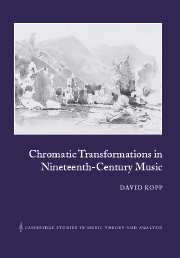Book contents
- Frontmatter
- Contents
- Foreword by Ian Bent
- Acknowledgements
- 1 Common-tone tonality
- 2 Three examples of functional chromatic mediant relations in Schubert
- 3 Key harmonic systems and notions of third relations from Rameau to Hauptmann
- 4 Hugo Riemann
- 5 Twentieth-century theory and chromatic third relations
- 6 Riemann's legacy and transformation theories
- 7 A chromatic transformation system
- 8 Chromatic mediant relations in musical contexts
- 9 Five analyses
- Bibliography
- Index
- Compositions cited
5 - Twentieth-century theory and chromatic third relations
Published online by Cambridge University Press: 22 September 2009
- Frontmatter
- Contents
- Foreword by Ian Bent
- Acknowledgements
- 1 Common-tone tonality
- 2 Three examples of functional chromatic mediant relations in Schubert
- 3 Key harmonic systems and notions of third relations from Rameau to Hauptmann
- 4 Hugo Riemann
- 5 Twentieth-century theory and chromatic third relations
- 6 Riemann's legacy and transformation theories
- 7 A chromatic transformation system
- 8 Chromatic mediant relations in musical contexts
- 9 Five analyses
- Bibliography
- Index
- Compositions cited
Summary
HEINRICH SCHENKER
Given the linear, diatonically oriented nature of his analytic method, one might expect that Heinrich Schenker was less than accepting of chromatic mediant relations. His later theory, after all, downplays the importance of local harmonic phenomena, assigning harmonic status sparingly to Stufen which by and large are fundamental diatonic steps of the key. It is of significant interest, then, to find chromatic mediants figuring at middleground and even background levels in many of the analytic diagrams of Der freie Satz. It is of further interest to ascertain how it can be that these chromatic harmonies, with their potentially key-denying contents, are integrated into Schenker's tonic-preserving analytic vocabulary. The seeds of this acceptance were sown well before, in Schenker's earlier work on harmony. Thus before examining the relevant material from Der freie Satz, it is worth examining Schenker's thought at that time.
Harmonielehre
Published in 1906, twenty-seven years before the appearance of Der freie Satz, Schenker's Harmonielehre lacks the theory of long-range voice-leading and fundamental structure integral to the mature work, while containing strong indications in that direction (documented throughout by Oswald Jonas in the current English translation). Harmonielehre, far from being a thorough, textbook-style investigation of the complete materials of tonal harmony, works more as a polemic for a particular conception of the mechanics of musical language.
- Type
- Chapter
- Information
- Chromatic Transformations in Nineteenth-Century Music , pp. 103 - 134Publisher: Cambridge University PressPrint publication year: 2002



